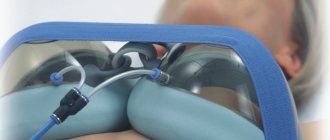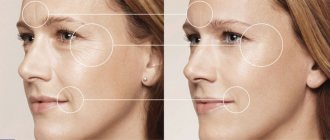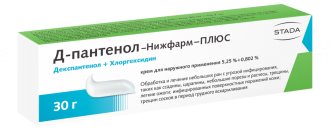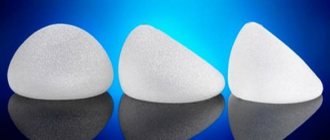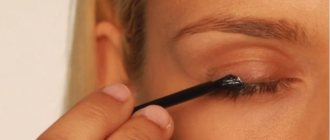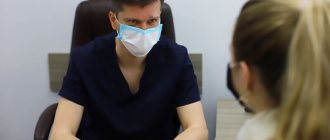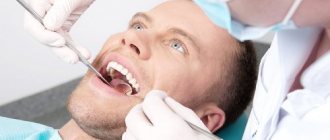Complications are typical for any surgical procedure, but the risks of their occurrence can vary significantly. First of all, the surgeon assesses the woman’s health status and identifies contraindications, which include:
- Inflammatory and infectious processes in the mammary glands.
- Diabetes.
- Pregnancy and breastfeeding period.
- Blood clotting disorder.
- Oncological diseases.
- Severe diseases of the liver, kidneys, lungs, heart, etc.
If breast augmentation is carried out in the presence of contraindications, the risks to the woman’s health and even life will be very high. In this regard, no surgeon will undertake such operations.
Complications in the early postoperative period
The most common early complications of breast augmentation surgery include:
- Hematomas and seromas. They develop as a result of accumulation of blood or wound discharge in the implant pocket. These complications are usually accompanied by severe symptoms, so they are not difficult to diagnose. Small hematomas and seromas go away on their own. In some cases, their puncture may be required. If you do not consult a doctor in time, such complications can lead to the breast becoming asymmetrical and painful, requiring removal of the endoprosthesis and its reinstallation.
- Infectious complications. When pathogens enter a wound, both pronounced and subclinical forms of infectious diseases can develop. They are usually manifested by fever, weakness, fatigue, and muscle pain. Treatment is usually conservative and consists of prescribing antibacterial drugs.
Risks and complications
Factors to Consider When Deciding to Have Breast Augmentation
- Regardless of what kind of surgery we are talking about (cosmetic or reconstructive), it should be remembered that this operation is not the last. After a certain period of time, additional surgery will be required. In addition, you will have to visit your doctor regularly throughout your life.
- Contrary to a very common belief, breast prostheses have an expiration date; therefore, they are not installed forever. After a certain time, the prosthesis will have to be removed or replaced with a new one.
- Many of the changes that will occur to your breasts after the installation of a prosthesis will be irreversible. If you later decide not to have endoprosthetics, you will be left with hollows, folds, wrinkles and other cosmetic defects.
Reduced effectiveness of mammography screening
Endoprosthesis replacement reduces the effectiveness of breast cancer diagnosis. The examining physician must be made aware of the presence of the prosthesis so that he or she can use special techniques to minimize the risk of rupture of the prosthetic shell. In addition, additional scanning in different projections may be required, which increases the dose of radiation that the woman receives. However, early detection of breast cancer is worth the risks associated with it.
It is recommended to undergo a mammographic examination the day before surgery and then 6-12 months after implant placement. The resulting images will make it possible to further monitor changes occurring in the mammary glands.
Self-examination of the mammary glands
After installation of the implant, it is necessary to conduct a monthly self-examination of the mammary glands. Ask your doctor to explain how to tell the difference between a prosthesis and breast tissue. If lumps or any suspicious changes are detected, a biopsy should be performed. Care must be taken not to damage the implant.
Closed capsulotomy
Closed capsulotomy, which involves squeezing the fibrous tissue formed around the implant in order to rupture the capsule, is not recommended, as it can lead to damage to the prosthesis itself.
Complications associated with implantation
There is a risk of complications with any surgery, such as effects of anesthesia, infection, swelling, redness, bleeding and pain. Along with this, additional complications are possible during implantation.
Collapse/rupture of the prosthesis
If the integrity of the shell is violated, the prosthesis may collapse. It can be immediate or gradual. Outwardly, this looks like a change in the size or shape of the breast. Collapse of the prosthesis can occur both in the first months after surgery and after several years. Causes may include damage to the prosthesis by surgical instruments during surgery, capsular contracture, closed capsulotomy, external pressure (eg, trauma or intense compression of the breast, excessive compression during mammography examinations), umbilical incision, or unknown/unexplained causes.
It should be remembered that the prosthesis wears out over time, which can lead to its rupture/collapse. Additional surgery is required to remove the collapsed prosthesis and install a new one.
Capsular contracture
Scar tissue or a capsule that forms around the implant and compresses it is called capsular contracture. In most cases, the onset of capsular contracture is preceded by infection, hematoma and seroma. Capsular contracture is more often observed with subglandular placement of the prosthesis. Characteristic symptoms are breast hardening and discomfort, pain, changes in the shape of the gland, protrusion of the implant and/or its displacement.
If there is excessive compaction and/or severe pain, surgery is necessary to remove the capsular tissue or the implant itself and possibly replace it with a new one. However, this does not eliminate the risk of recurrence of capsular contracture.
Pain
After implantation of a breast prosthesis, pain of varying intensity and duration may occur. This pain occurs as a result of pinched nerves or difficulty contracting muscles, which can be caused by improperly sized prosthesis, poor placement, surgical errors, or capsular contracture. If severe pain occurs, your doctor should be notified.
Additional surgery
After a certain period of time, surgery may become necessary to replace or remove the prosthesis. Surgery to remove the prosthesis may also be necessary if the prosthesis is collapsing, capsular contracture, infection, prosthesis displacement, or calcium deposits. Most women, having removed the old prosthesis, install a new one. Women who decide not to have a new prosthesis implanted should be prepared to experience dimples and/or folds and other cosmetic defects.
Dissatisfaction with the cosmetic effect
The cosmetic effect of the operation may not always satisfy the patient. Possible wrinkles, asymmetry, displacement of the implant, incorrectly selected size, undesirable shape, the ability to palpate the implant, rough (irregularly shaped, raised) and/or too large or wide suture.
The likelihood of these defects occurring can be reduced by carefully planning the operation and choosing the right technique. However, even in this case, this possibility cannot be completely ruled out.
Infection
Any surgical intervention is associated with the risk of infection. In most cases, the infection develops within a few days or weeks after surgery. If the infection cannot be controlled with antibiotics and the presence of the implant makes treatment difficult, the prosthesis may need to be removed. Installation of a new implant is possible only after recovery.
In rare cases, toxic shock syndrome may develop after implantation of a breast prosthesis, which can be life-threatening. Symptoms include sudden fever, vomiting, diarrhea, fainting, dizziness and/or rash. If these symptoms appear, you should immediately consult a doctor and begin treatment.
Hematoma/seroma
A hematoma is an accumulation of blood (in this case around an implant or incision), and a seroma is an accumulation of serous fluid, which is the aqueous component of blood. Postoperative hematoma and seroma may promote infection and/or capsular contracture and may be accompanied by swelling, pain, and bruising. Hematoma formation is most likely in the postoperative period. However, it can appear at any other time with a chest bruise. As a rule, small hematomas and seromas resolve on their own. Large hematomas or seromas may require drainage. In some cases, removal of the drainage tube will leave a small scar. When introducing drainage, it is important not to damage the implant, which can lead to collapse/rupture of the prosthesis.
Changes in sensation in the nipple and breast area
After implantation of the prosthesis, sensitivity in the nipple and breast area may change. Changes vary widely - from significant sensitivity to the absence of any sensations. These changes may be temporary and may be permanent, affecting sexual sensitivity or ability to breastfeed.
Breast-feeding
It has not yet been possible to obtain data confirming the diffusion of small amounts of silicone from the shell of prostheses into the surrounding tissues and their passage into breast milk. It is also unknown what effect silicone can have on a child if it enters the body of an infant through mother's milk. Currently, there are no methods to quantify the silicone content in breast milk. However, a study comparing the levels of silicone in the breast milk of women with and without dentures suggests that the levels are similar between women with saline implants and women with gel implants.
Regarding breastfeeding ability, the survey found that the proportion of women unable to breastfeed among women with implants was 64% versus 7% among women without implants. When a prosthesis is implanted through a peripapillary incision, the ability to breastfeed is significantly reduced.
Calcium deposits in the tissues surrounding the implant
During mammographic examination, calcium deposits may be mistaken for malignant tumors. In order to differentiate them from cancerous tumors, in some cases a biopsy and/or surgical removal of the implant may be required.
Delayed wound healing
In some cases, the incision area does not heal for a long time.
Prosthesis rejection
Insufficient thickness of the skin flap covering the prosthesis and/or prolonged wound healing can lead to the prosthesis being rejected and clearly visible through the skin.
Necrosis
Necrosis, or death of tissue around the prosthesis, can cause permanent deformation of the scar tissue and prevent the wound from healing. In such cases, it is necessary to resort to surgical correction and/or removal of the prosthesis. Necrosis is often preceded by infection, the use of steroid drugs to debride the surgical pocket, smoking, chemotherapy/radiotherapy, and intensive heat and cold therapy.
Breast tissue atrophy/chest wall deformity
The pressure that the prosthesis puts on the breast tissue can cause it to thin and shrink. This can happen both with an implanted prosthesis and after its removal without replacement.
Other complications
Connective tissue diseases
Concerns about the relationship between breast implant placement and the occurrence of autoimmune or connective tissue diseases, such as lupus, scleroderma or rheumatoid arthritis, arose after press reports of cases of these diseases developing in a small number of women with breast implants. glands. However, the results of several large epidemiological studies that examined women with breast prostheses and women who had never had breast reconstruction indicate that the incidence of such diseases among women in both groups is approximately the same. Nevertheless, many women believe that it was the prosthesis that caused their illness. According to published data, endoprosthetics does not increase the risk of developing breast cancer.
Read more: ►Contraindications for breast augmentation surgery
This is interesting:
•Photo gallery •Selection of implants •Selection of a surgeon •Preparation and rehabilitation
List of surgeons
Make an appointment with a specialist
Long-term postoperative complications
Several months after surgery, some women may experience the following complications:
- Reduced sensitivity up to its complete loss. Usually there is a temporary loss of sensitivity in the nipple area. This complication develops as a result of damage to small nerve fibers that are located in the skin. Sensitivity usually returns after a few months, without any medical help.
- Implant displacement. It develops as a result of violation of the rules of conduct during rehabilitation, in particular, violation of the regime of wearing compression garments, or as a result of the surgeon’s failure to comply with the technical nuances of the operation. This complication is eliminated with repeated mammoplasty.
- Scar formation. Scars always form at the site of the incision, but in most cases they are thin and invisible. In about 1% of women, the scars stretch and increase in size, which affects the appearance of the breasts. They can be eliminated with surgery, but it is carried out no earlier than six months after mammoplasty.
Sports after breast augmentation
The issue regarding sports requires special attention. Even minor physical activity is contraindicated for a month after breast augmentation. You cannot lift weights, run, or do fitness. Jumping rope, dancing and performing plyometric exercises is strictly prohibited!
It is important to understand that sports after breast augmentation are prohibited only for 1-1.5 months (or a period determined by the attending physician). In the future, you can return to normal physical activity and forget about all restrictions. Fitness, strength training, running or dancing - implants do not interfere with training, and exercise does not negatively affect the aesthetic result of mammoplasty.
Sex after breast augmentation is not contraindicated, provided that you do not remove compression garments, lie on your stomach, or violate any other recommendations of your doctor. However, in the first 5-7 days, abstaining from intimacy will be a reasonable and most correct decision.
Complications that are very rare
The rupture of the implant is accompanied by a violation of the integrity of its shell. Typically, this complication develops as a result of careless actions of the surgeon, as a result of destruction of the implant wall, manufacturing defects, or chest injuries. Modern implants are filled with silicone gel, which does not spread or react with tissues, so there are no serious consequences for a woman’s health in this case.
The rupture can be intracapsular or extracapsular. In the first case, the filler remains within the implant pocket, and in the second, it extends beyond the fibrous capsule. Both of these conditions are usually manifested by aesthetic changes - deformation, asymmetry, change in breast size.
Capsular contracture developed very often (in 40-60% of cases) when using old first and second generation implants. This complication is a normal reaction of the body to a foreign body. He tries to limit the implant to a fibrous capsule from other tissues. The problem is that this capsule is not elastic and compresses the endoprosthesis, resulting in a pronounced compaction in the chest. Modern implants are distinguished by a special type of surface that prevents the formation of capsular contracture. Therefore, currently the risk of developing this complication is less than 10%. It can increase under the influence of other factors, including:
- Subclinical hematoma.
- The pocket is not large enough for the implant.
- Infectious complications after surgery.
However, no connection was found between the likelihood of capsular contracture formation and the type of filler.
The latest models of endoprostheses can reduce the risk of developing this complication to 3%, while in some women it may be higher. Accurate data that would allow us to understand the reasons for the development of capsular contracture have not yet been obtained. Therefore, conscientious manufacturers include a warning insert in each package of implants, which states the possible development of capsular contracture, in which the appearance of the breast may change, which will require repeated surgery.
General recommendations
It remains to talk about the general rules of the rehabilitation period. It is better to take sick leave during the first week. Try to get as much rest as possible and avoid overwork and housework. You can shower by the end of the first week.
For 1-2 months you should not go to the sauna, visit the solarium, or sunbathe on the beach. It is advisable to give up smoking and alcohol, and do not abuse pharmaceutical drugs. Take only those medications prescribed by your doctor.
If you follow the surgeon's recommendations, recovery proceeds smoothly and does not cause significant discomfort. For example, patients of the SOHO CLINIC medical center return home on the third day after mammoplasty and subsequently visit the clinic only on days of routine examination. Make an appointment with a plastic surgeon and get comprehensive answers to all your questions!
Local contraindications
These contraindications include the characteristics of the soft tissues of the breast that do not allow the installation of implants with an acceptable aesthetic result.
Most often, we are talking about very thin breast tissues that cannot sufficiently cover the implant, which leads to its visualization, i.e. the edge of the implant is visible, and ripples and folds are noted on the chest.
In such cases, installing implants under the pectoralis major muscle can sometimes be a salvation, but there is a small category of patients for whom this does not help either. In such cases, it is better to refuse surgery.
In any case, it is necessary to remember that contraindications for surgery are set by the doctor. The patient’s task is to fully inform her surgeon about her diseases. With this approach, the likelihood of complications approaches a minimum.
↑ What to do with hyperthermia
Is it necessary to lower the temperature? Only as a temporary measure until seeking medical help. The main reasons for the increase in indicators above the norm:
- Infection - it can result from a violation of the surgical technique or occur as a result of insufficient care of the sutures.
- Seroma is an accumulation of serous fluid in the area where a breast implant is installed.
- Large hematoma - if a large accumulation of blood clots has formed in the cavity of the pocket formed during mammoplasty, this can cause an increase in temperature.
- Rejection of the endoprosthesis, violation of its integrity.
And if seroma, in theory, can still “resolve” on its own, then the idea of waiting out the infection by simply bringing down the rising temperature is extremely dangerous. Therefore, the first thing to do is to contact the surgeon who performed mammoplasty for extensive diagnostics.
Only a doctor is able to establish the exact cause of hyperthermia and determine whether it is a relative norm or a potentially dangerous condition that requires additional treatment. And determine what exactly this treatment will be.
Reasons for appearance
The “washboard effect,” as ripping is also called, can be seen as swelling subsides while the skin is still stretched. There is no need to worry about it, since at this stage of recovery this phenomenon is temporary. It will disappear as the skin returns to its original state. Most often, ripping can be seen in thin women whose mammary glands have a small volume. As already mentioned, this is due to the fact that this complication is associated with insufficient skin to cover the implant. In obese patients who have a sufficient amount of subcutaneous fat and well-developed mammary glands, this phenomenon is absent.
The risk of irregularities is much higher when choosing large-volume implants. The location of the implant also plays an important role. In this regard, it is advisable to place it under the muscle, which allows the formation of a large volume of tissue over the prosthesis. Often the surface of the implant becomes a decisive factor: if it is rough, then the risk of “ripples” increases. The risk of ripping is especially high if a saline-filled implant was used. The natural consistency of silicone gel makes it possible to reduce this manifestation, and it can be minimized by using POLYTECH® implants, which are filled with a cohesive gel.
How much does it cost to treat complications?
- Replacement of one breast implant (without the cost of the implant) – RUB 151,800.
- Correction of implant location – RUB 101,200.
- Correction of nipple retraction – RUB 101,200.
- Removal of implants – RUB 116,600.
- Areola reduction – RUB 151,800.
At Euroonco, operations on the mammary glands are performed with minimal risk of complications, because we employ experienced doctors and use modern equipment and implants. We know what to do if complications arise after breast augmentation or reduction.
Absolute contraindications
- The presence of any acute disease. Most often we are talking about viral respiratory diseases or diseases such as tonsillitis or bronchitis.
- Chronic disease in the acute stage. Any chronic disease in the acute stage will be a temporary contraindication to surgery until recovery or remission is achieved.
- The presence of a malignant neoplasm. An absolute contraindication until complete recovery and permission from the attending oncologist.
- Disturbances in the blood coagulation system. Violations can be either in the direction of decreased coagulability, in which case bleeding is possible, or in the direction of increased coagulation, in which case vein thrombosis is possible. An absolute contraindication to surgery until the violations are eliminated.
- Pregnancy. During pregnancy, any operations other than vital ones are contraindicated.
- Less than six months after cessation of lactation. In this case, the mammary gland has not yet taken its final shape after lactation and will still change. For this reason, there is no need to rush, since subsequent changes may worsen the result of the operation.
- Age under 18 years.
- Presence of mental illness.
- Pustular skin diseases in the area of surgery. This can lead to suppuration of the implantation pocket.
- Diabetes mellitus type 1. With this disease, healing worsens, but in each specific case the surgeon makes a decision based on the clinical picture of the disease.
Mammoplasty - what not to do after surgery
What can’t be done after mammoplasty, besides the main nuances? Here are other important recommendations and restrictions after mammoplasty:
- Sports and physical activity. After the sutures are removed, any physical activity is prohibited. You cannot lift weights or bend over for the first month. If you engage in sports, dancing, or other activities and it is important to stay in shape, the issue is discussed separately with a plastic surgeon. Recovery occurs differently depending on the type of mammoplasty. If breast augmentation is performed and the implant is placed under the mammary gland, recovery is faster, if under the muscle it takes longer.
- Sex. Banned for the first two to three weeks after surgery. Why can't you have sex after mammoplasty? Excitement causes tension in the chest, which can lead to inflammation or tearing of the stitches. Sex also affects changes in hormonal levels, which should remain at a stable level during the postoperative period.
- Taking medications. Before the operation, taking medications and vitamins is discontinued, with the exception of certain cases. The woman should stop taking hormonal medications. After plastic surgery, your plastic surgeon will tell you when you can resume taking them. A mandatory ban at this time is blood thinning medications, as they can cause bleeding.
- Smoking and drinking alcohol. They are prohibited, and there are reasons for this: smoking constricts blood vessels, alcohol negatively affects the functioning of the heart, both substances slow down the rehabilitation process as a whole. How long can you drink alcohol after mammoplasty? It is recommended to quit smoking and drinking alcohol for 2-3 months.
- A tan. It is worth avoiding exposure to sunlight on the skin for several months - if it is a solarium, you should not sunbathe in the sun for about a year.
- Bath and sauna. Visiting is prohibited for several months.
- Trips. Flights are allowed two weeks after plastic surgery.
You can imagine the restrictions after mammoplasty in the first months and the recovery process like this:
The first day or two after the operation, you withdraw from the intervention, take painkillers, and you can apply an ice compress to your chest. After you are discharged, you can return to work in a few days. After 7-10 days, the stitches are removed, swelling goes away in 2-3 weeks, the likelihood of bleeding decreases, and a month after mammoplasty the wounds will heal.
In 2-3 months you will return to your normal lifestyle and be able to play sports. The breasts will finally take shape and become soft within 9 months. And within a year and a half, the scars will become invisible.
Mammoplasty - restrictions after surgery
To prepare for surgery, you need to stop taking medications, alcohol and smoking, and avoid stress. You should rest well, get enough sleep, and eat well.
The restrictions after breast augmentation or other types of mammoplasty are the same, but many other rules are added to them. They are mandatory, so you need to follow the recommendations to avoid any complications and health problems.
Main restrictions after breast mammoplasty:
- You shouldn't work for the first few days. If the activity does not involve physical exertion, you can return to it after a week, as long as it does not require a lot of moving and raising your arms.
- Mobility. In the first 10 days or 2 weeks, which depends on the recovery process, you should not raise your arms. Why can’t you raise your arms after mammoplasty? So that the stitches do not come apart, bleeding or reconstructive processes do not begin.
- Nutrition. Everything is not so strict here - minimize salt intake, do not drink too much liquid and water. You should maintain weight until the end of rehabilitation so that the breasts do not change size and shape.
- Lingerie and clothes. Before surgery, you should buy a compression bra that will fit properly and will not press or rub the skin. In special compression garments, the breasts are held in the required position. Patients should wear underwear for the first month without taking them off.
- Hygiene after mammoplasty. If the wounds are healing well, you can take a shower on the fourth day after surgery. For the first time, cosmetic procedures are contraindicated.
- Dream. Why can't you sleep on your side after mammoplasty? So that there are no disturbances in the process of breast restoration, swelling or bedsores. In the first days, it is better to sleep half-sitting so that there is no strain on the chest.
